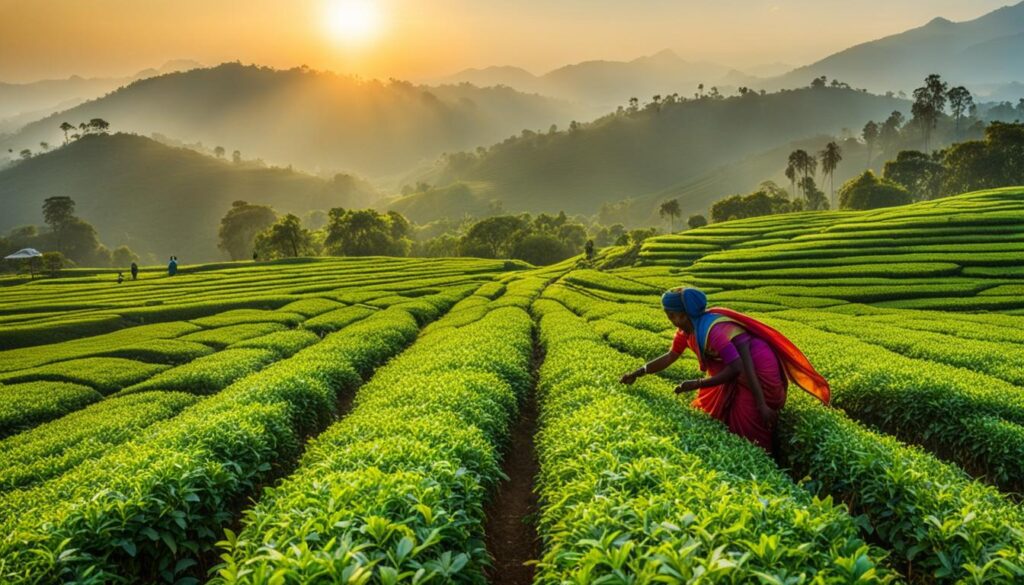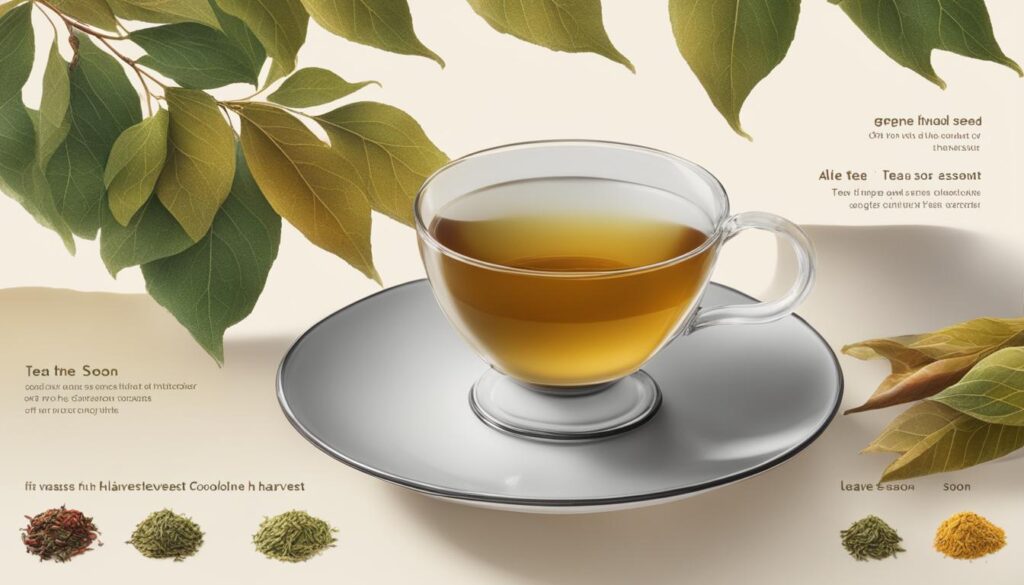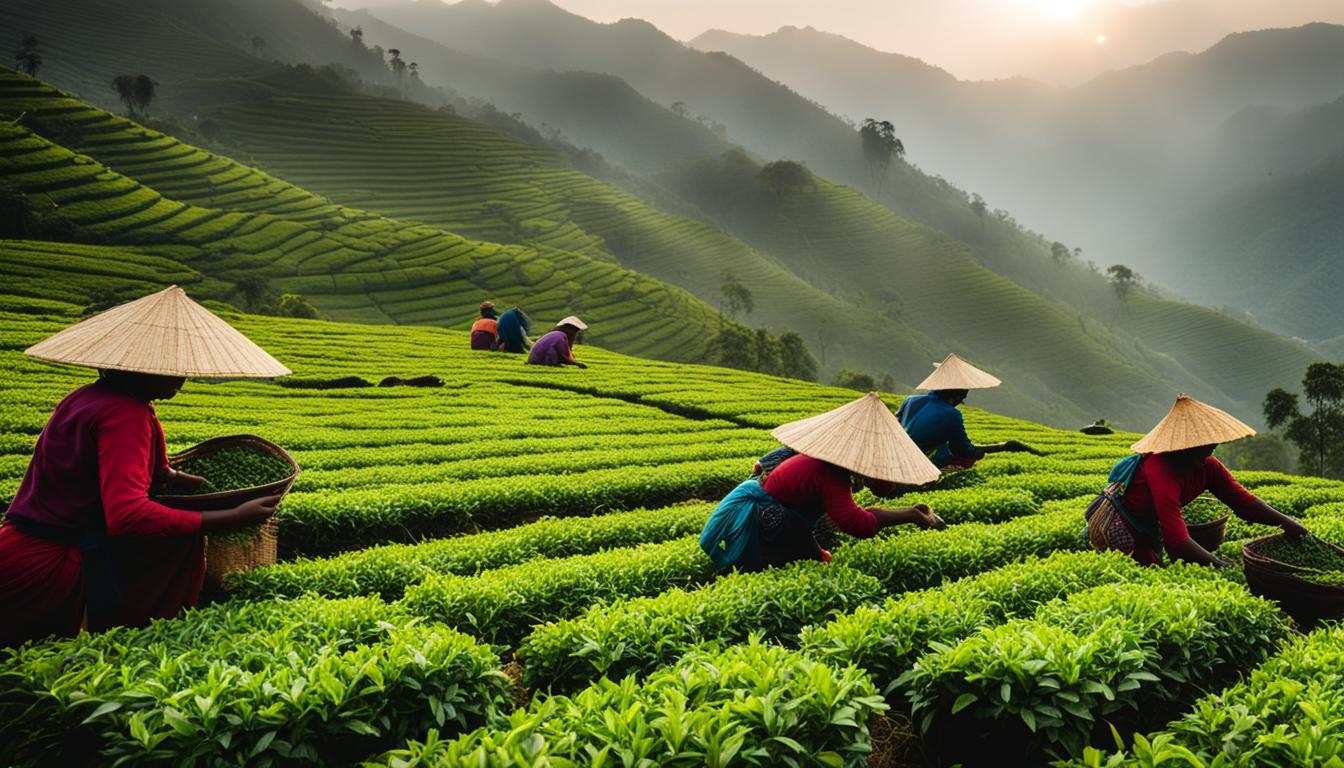Welcome to our comprehensive guide on tea harvesting seasons! Whether you’re a tea enthusiast or a tea producer, understanding the timing and techniques of tea harvest is essential for achieving the best flavor and aroma. In this article, we’ll explore the impact of harvest time on tea flavor and provide you with insights into the different harvesting seasons in various regions. So grab a cup of your favorite tea and let’s dive in!
Tea harvesting seasons can vary by region and are influenced by weather conditions. The timing of the harvest is crucial, as missing it can result in crop loss. Each growing region has its own terminology for harvest periods. For example, in India and Nepal, the first harvest of the year is called the First Flush, while in China, it is known as Pre-Qing Ming tea. The harvest season can start as early as March and last until November, with variations based on elevation and weather.
But why does harvest time matter for tea flavor? The flavor, aroma, and overall quality of tea can be influenced by when the leaves are harvested. Tea leaves picked during the first flush, after a period of dormancy, are often considered the most sought after and expensive. Manual tea harvesting methods are employed to ensure only the finest leaves are selected for processing. Post-harvest processing techniques, such as withering, rolling, and drying, also play a crucial role in developing the flavor of tea.
In the following sections, we’ll take a closer look at the tea harvesting seasons in different regions, including India, Sri Lanka, Nepal, China, Japan, South Korea, and East Africa. We’ll explore the specific timing, techniques, and cultural aspects surrounding tea harvest in each region. Additionally, we’ll discuss the influence of harvest season on tea flavor and the labor management involved in tea harvest. So stay tuned for a deep dive into the fascinating world of tea harvesting!
Before we dive into the details, let’s quickly recap the key takeaways from this article:
Key Takeaways:
- Understanding the timing of tea harvest is crucial for achieving the best flavor and aroma.
- Each region has its own harvest terminology, such as First Flush in India and Pre-Qing Ming tea in China.
- Tea quality assessment during harvest is important to ensure the best flavor and aroma.
- The timing of tea harvest can vary based on region, elevation, and weather conditions.
- The flavor of tea can be influenced by the specific season in which the leaves are harvested.
Now that we have a solid foundation of tea harvesting seasons, let’s explore the specific harvest timings and cultural aspects in different regions. Join us in the next sections as we delve into the captivating world of tea harvest!
Tea Harvesting Seasons in India, Sri Lanka, and Nepal
In the lush tea-growing regions of India, Sri Lanka, and Nepal, the timing of tea harvest plays a crucial role in determining the flavor and quality of the tea leaves. Let’s explore the unique harvest seasons and techniques employed in these regions.
Darjeeling Harvest Season:
In the picturesque Darjeeling region of India, the tea harvest season spans from late March to early November. The harvest is divided into four distinct flushes: the First Flush, Second Flush, Monsoon Flush, and Autumnal Flush. Each flush has its own characteristics and flavors, making Darjeeling teas highly sought after by tea connoisseurs around the world. During the First Flush, which occurs in late March to April, delicate and aromatic teas with a light golden hue are produced. The Second Flush, taking place from May to June, yields teas with fuller flavors and a rich amber color.
Assam Harvest Season:
Assam, another prominent tea-growing region in India, experiences a longer tea harvest season that extends from March to December. The highest quality teas are typically harvested during the first and second flushes, which occur in April and May. These teas are known for their robust flavors, malty notes, and bright liquor. Following the first and second flushes, other grades of tea are harvested, contributing to the diverse selection of Assam teas available in the market.
“The timing of tea harvest in India, Sri Lanka, and Nepal is crucial in capturing the distinctive flavors and characteristics of each region’s teas.”
In Sri Lanka, formerly known as Ceylon, tea harvesting is a year-round activity due to the favorable climate. However, the highest quality teas are harvested during specific periods known as the “Quality Seasons.” These seasons vary depending on the elevation of the plantations. For instance, the High Grown teas are harvested from January to March, while the Medium Grown teas are harvested from April to August. The Low Grown teas, on the other hand, are harvested from September to December. This careful timing ensures that the teas exhibit their unique flavors and aromas.

In Nepal, the tea harvest season aligns with the seasons in Darjeeling, with similar flushes and corresponding flavors. The First Flush, Second Flush, Monsoon Flush, and Autumnal Flush in Nepal produce teas that are highly regarded for their delicate profiles and distinct regional characteristics.
Understanding the tea harvesting seasons and techniques employed in India, Sri Lanka, and Nepal is essential for appreciating the range of flavors and nuances found within their unique teas.
Tea Harvesting Seasons in China, Japan, and South Korea
China, Japan, and South Korea are renowned for their rich tea cultures and distinct tea harvesting seasons. Each country has its own unique timing and traditions when it comes to the harvest, resulting in a wide variety of flavors and aromas.
In China, the tea harvest season varies among different regions and elevations. It typically starts as early as March and can last until late November. Two of the most highly regarded harvest periods are the Ming Qian tea, which is picked before the Qing Ming festival, and the Yu Qian tea, harvested before the Grain Rain festival. These teas are renowned for their delicate flavors and fragrances.
Japan’s tea harvest season begins in late April and ends in early October. The first harvest, known as Shincha, is highly prized for its vibrant green color and fresh, grassy flavor. This early harvest captures the essence of spring and is eagerly anticipated by tea enthusiasts around the world.
In South Korea, the tea harvest follows the dates on the lunisolar calendar. Different grades of tea are harvested at specific times throughout the year. The first harvest, known as Ujeon, is considered the best and is characterized by its strong, sweet flavor. The subsequent harvests, known as Sejak and Jungjak, offer their own unique profiles and are cherished by tea connoisseurs.
Tea Harvest Seasons in China, Japan, and South Korea
| Country | Harvest Season | Characteristics |
|---|---|---|
| China | March – November | Various harvest periods, including Ming Qian and Yu Qian, with delicate flavors |
| Japan | April – October | Shincha harvest captures the essence of spring with vibrant green color and fresh flavor |
| South Korea | Throughout the year | Ujeon, Sejak, and Jungjak harvests offer strong, sweet flavors and unique profiles |
By understanding the tea harvesting seasons in China, Japan, and South Korea, tea enthusiasts can appreciate the nuances and flavors of these exceptional teas. Whether it’s the delicate and fragrant teas of China, the fresh and vibrant Shincha of Japan, or the distinct flavors of Ujeon, Sejak, and Jungjak in South Korea, each harvest season offers a unique and delightful tea experience.
Tea Harvesting Seasons in East Africa
East Africa is home to several countries known for their tea production, such as Kenya, Malawi, Mozambique, Uganda, Rwanda, Zimbabwe, Burundi, and Ethiopia. Unlike other regions, these countries experience year-round tea harvesting due to the absence of a cold season. The favorable climate allows for continuous growth and harvesting of tea leaves. However, the timing of tea harvest in East Africa is still influenced by the region’s unique climate patterns, particularly the rainy seasons.
As rainfall and temperature fluctuations play a significant role in tea plant growth, the peak tea production in East Africa coincides with the rainy seasons. The wetter periods provide optimal conditions for the tea plants to thrive and produce high-quality leaves. Therefore, tea harvest timing in East Africa can vary depending on the specific rainfall patterns of each country and region.
To illustrate the impact of climate on tea harvest timing in East Africa, consider the following table:
| Country | Tea Harvest Seasons |
|---|---|
| Kenya | Year-round (peaks during the long rains from March to May and the short rains from October to December) |
| Malawi | Year-round (peaks during the wet season from November to March) |
| Uganda | Year-round (peaks during the rainy seasons from March to May and October to November) |
| Ethiopia | Year-round (peaks during the wet season from June to September) |
Understanding the impact of climate on tea harvest timing in East Africa is essential for tea farmers in order to plan their harvesting schedules accordingly. By aligning the harvesting process with the optimal growing conditions, tea producers can ensure the production of high-quality teas that showcase the unique flavors and characteristics of the region.
The Influence of Harvest Season on Tea Flavor
The harvest season plays a crucial role in determining the flavor of tea. The timing of the harvest, as well as the manual tea harvesting methods employed, can significantly impact the taste, aroma, and overall quality of the final product. Tea leaves harvested during the first flush, after a period of dormancy, are often of the highest quality and carry a distinct flavor profile.
In the quest for the best flavor, tea harvesters employ manual harvesting techniques. Skilled workers carefully hand-pick only the finest leaves, ensuring that only the freshest and most flavorful ones are selected. This meticulous attention to detail results in teas with complex and nuanced flavors.
“The timing of the harvest is critical in capturing the essence of the tea. Each season brings its own unique flavors and characteristics, and it is our responsibility as tea producers to carefully select the leaves that will provide the best taste experience for consumers.”
Once the tea leaves are harvested, post-harvest processing methods are employed to further enhance the flavor. Techniques such as withering, rolling, and drying are used to transform the freshly plucked leaves into the tea we consume. These processing methods can vary depending on the type of tea and the desired flavor profile, allowing for a wide range of flavors and aromas to be produced.

Table: Flavors of Tea by Harvest Season
| Harvest Season | Flavor Profile |
|---|---|
| First Flush | Light and delicate with floral notes |
| Second Flush | Rich and full-bodied with fruity undertones |
| Monsoon Flush | Mellow and earthy with a hint of sweetness |
| Autumnal Flush | Robust and malty with a warm, spiced flavor |
As tea enthusiasts, we can appreciate the intricate relationship between harvest season and tea flavor. Exploring teas from different regions and harvest seasons allows us to discover a world of flavors, each unique and captivating in its own way. So let’s raise our cups to the skilled harvesters and their dedication to bringing us the finest teas with unparalleled flavors!
Tea Harvesting and Labor Management
Tea harvests are not only a significant event in the tea industry but also a time of celebration and appreciation for the hard work of harvesters. Managing labor during the harvest season is crucial to ensure efficient and sustainable tea production. From manual picking to processing, tea harvests require a skilled workforce to produce high-quality teas.
One of the key aspects of labor management during tea harvests is ensuring that harvesters have the necessary tools and equipment to perform their tasks effectively. Proper harvesting shears, for example, are essential for carefully picking the tea leaves. Additionally, trainings and workshops can be organized to educate harvesters on best practices in tea harvesting and processing.
Tea harvest festivals are a wonderful way to honor the laborers and showcase the rich tea culture of different regions. These festivals often involve traditional ceremonies, cultural performances, and activities that promote community engagement. They provide an opportunity for tea enthusiasts to learn more about the tea harvesting process and the people behind their favorite cup of tea.
Table: Famous Tea Harvest Festivals
| Festival | Location | Date |
|---|---|---|
| Qingming Festival | China | April 4th or 5th |
| First Flush Festival | India (Darjeeling) | March – April |
| Chuseok Festival | South Korea | August – September |
| Obon Festival | Japan | August 13th – 15th |
| Nuwara Eliya Season Opening | Sri Lanka | April |
These festivals not only bring together tea enthusiasts but also contribute to the local economy by attracting tourists. They serve as a reminder of the hard work and dedication that goes into every cup of tea we enjoy. So, next time you savor your favorite brew, take a moment to appreciate the laborers who make it all possible.
Conclusion
Understanding the tea harvesting seasons and their impact on flavor is crucial for both tea producers and enthusiasts. Each region has its own unique characteristics and flavors that can be discovered by exploring the different harvest periods. During the tea harvest, it is essential to assess the quality of tea leaves to ensure only the finest leaves are selected for processing. This assessment helps guarantee that the tea produced maintains its exceptional flavor and aroma.
Proper equipment and tools play a vital role in the tea harvesting process. Precise harvesting shears are used to carefully pick the tea leaves, ensuring minimal damage and preserving their quality. Additionally, the careful handling of leaves during processing is significant in maintaining the overall excellence of the final tea product.
By understanding the nuances of tea leaf quality assessment during harvest and utilizing the appropriate tools, we can fully appreciate the flavors and characters of teas from different regions. Whether you are a tea producer or a tea enthusiast, embracing the art of tea harvesting and using the right techniques will help you create and enjoy truly exceptional cups of tea.
FAQ
When is the best time to harvest tea leaves?
The timing of tea harvest varies by region and is influenced by weather conditions. Each growing region has its own terminology for harvest periods, such as flushes in India and Nepal and dates in the East Asian lunisolar calendar in China, Taiwan, and South Korea.
What are the different tea harvest seasons in India, Sri Lanka, and Nepal?
In India, the tea harvest season in Darjeeling and Nepal lasts from late March to early November, divided into four flushes: first flush, second flush, monsoon flush, and autumnal flush. Assam’s harvest season extends from March to December, with the highest quality teas harvested during the first and second flushes.
What are the tea harvest seasons in China, Japan, and South Korea?
The tea harvest season in China varies among regions and elevations and can start as early as March and last until late November. Japan’s harvest season begins in late April and ends in early October, with the first harvest, known as Shincha, being highly prized. South Korea’s tea harvest follows dates on the lunisolar calendar, with the first harvest, Ujeon, considered the best.
How do climate conditions affect tea harvest timing in East Africa?
East African countries, including Kenya, Malawi, Mozambique, Uganda, Rwanda, Zimbabwe, Burundi, and Ethiopia, have year-round tea harvesting due to the absence of a cold season. The peak tea production coincides with rainy seasons, and the climate significantly affects the timing of tea harvest.
How does the harvest season impact the flavor of tea?
Tea leaves harvested during the first flush, after a period of dormancy, are often of the highest quality and carry a distinct flavor profile. Manual tea harvesting methods are employed to ensure only the finest leaves are picked. Post-harvest processing, including withering, rolling, and drying, also affects the flavor of tea.
How is labor managed during the tea harvest season?
Tea harvest often requires significant manual labor. Tea harvest festivals are celebrated in various regions to honor the hard work of harvesters and promote community engagement. Managing labor during the harvest season is essential for efficient and sustainable tea production.
What is the importance of tea leaf quality assessment during harvest?
Tea leaf quality assessment during harvest is crucial to ensure that only the best leaves are selected for processing. The use of appropriate equipment and tools, such as precise harvesting shears and careful handling of leaves during processing, also contributes to the overall quality of the final tea product.





